Table of Contents
- Understanding Zoonotic Infections
- Common Zoonotic Infections Transmitted by Cats
- How Cats Contract and Spread Zoonotic Infections
- Symptoms of Zoonotic Infections in Cats
- Prevention Measures for Zoonotic Infections
- Treatment Options for Zoonotic Infections in Cats
- Importance of Regular Veterinary Checkups for Cats
- Educating Yourself and Others on Zoonotic Infection Risks
- The Role of Cat Owners in Reducing Zoonotic Infection Risks
- Conclusion: Protecting Yourself and Your Feline Companion.
Understanding Zoonotic Infections
Zoonotic infections are diseases that are transmitted between animals and humans. These infections can be caused by bacteria, viruses, fungi, and parasites. The transmission of zoonotic infections can occur through direct contact with infected animals or their secretions, through bites or scratches, or by ingesting contaminated food or water.
How do Zoonotic Infections Spread?
The spread of zoonotic infections can occur in several ways. One of the most common ways is through direct contact with an infected animal. This can happen when you touch or pet an animal that is infected with a zoonotic disease. Bites and scratches from infected animals can also lead to transmission.
Another way that zoonotic infections can spread is through the consumption of contaminated food or water. This can occur when you eat undercooked meat, eggs, or dairy products that are contaminated with zoonotic bacteria or parasites.
Who is at Risk of Zoonotic Infections?
Anyone can be at risk of contracting a zoonotic infection, but some groups are more susceptible than others. People with weakened immune systems, such as the elderly, young children, and those with chronic illnesses, are more likely to develop severe symptoms.
Conclusion
Understanding the risks associated with zoonotic infections is important for both cat owners and non-owners alike. By taking precautions and educating ourselves on the risks, we can reduce the spread of these diseases and protect ourselves and our loved ones.
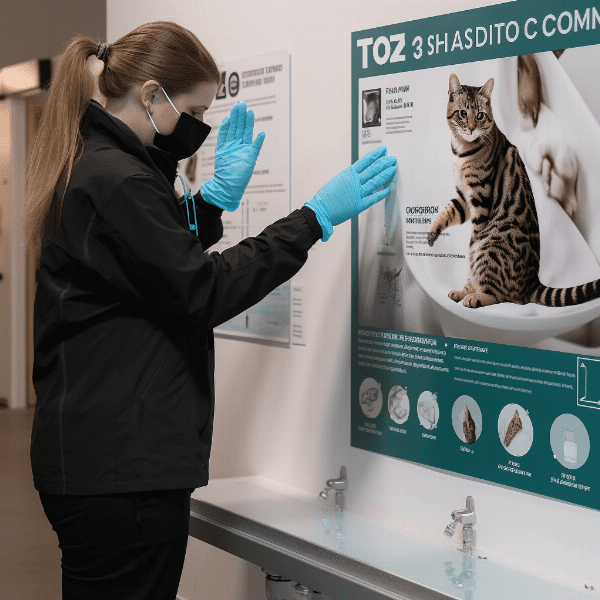
Common Zoonotic Infections Transmitted by Cats
Cats are beloved pets, but they can also transmit zoonotic infections to humans. In this section, we will discuss some of the most common zoonotic infections transmitted by cats and how they can be prevented.
Ringworm
Ringworm is a fungal infection that can be transmitted to humans through direct contact with an infected cat’s skin or hair. It can also be contracted through contact with contaminated objects, such as bedding or grooming tools. Symptoms of ringworm in humans include a circular rash on the skin and hair loss.
To prevent the spread of ringworm, it is important to keep your cat’s living space clean and to wash your hands after handling them. Regular grooming and veterinary check-ups can also help to detect and treat ringworm early.
Toxoplasmosis
Toxoplasmosis is a parasitic infection that is commonly associated with cats. The infection is caused by the Toxoplasma gondii parasite, which is found in infected cat feces. Humans can become infected by ingesting the parasite through contaminated food or water, or by handling infected cat litter.
Symptoms of toxoplasmosis in humans can include flu-like symptoms and swollen lymph nodes, but most people who become infected will not show any symptoms. However, the infection can be particularly dangerous for pregnant women, as it can lead to birth defects.
To prevent toxoplasmosis, it is important to avoid handling cat litter if you are pregnant or have a weakened immune system. You should also wash your hands thoroughly after handling your cat, particularly before preparing or eating food.
Rabies
Rabies is a viral infection that is almost always fatal if left untreated. The infection is transmitted through the saliva of infected animals, typically through bites or scratches. Cats are one of the animals that can transmit rabies to humans.
To prevent rabies, it is important to vaccinate your cat against the virus and to avoid contact with wild animals, particularly if they appear sick or aggressive. If you are bitten or scratched by a cat or any other animal, seek medical attention immediately.
Conclusion
While cats can transmit zoonotic infections to humans, the risk can be greatly reduced through proper care and hygiene. Regular veterinary check-ups and good hygiene practices, such as washing your hands after handling your cat, can help to prevent the spread of these infections. By being aware of the risks and taking precautions, you can enjoy a happy and healthy relationship with your feline companion.

How Cats Contract and Spread Zoonotic Infections
Cats can contract and spread zoonotic infections in various ways. In this section, we will discuss how cats can become infected with zoonotic diseases and how they can transmit these diseases to humans.
Contracting Zoonotic Infections
Cats can contract zoonotic infections from other infected animals or through environmental exposure. For example, they can become infected with Toxoplasma gondii, the parasite that causes toxoplasmosis, by consuming infected prey or contaminated food and water.
Cats can also become infected with zoonotic infections through bites or scratches from infected animals or through contact with their infected bodily fluids. For example, they can contract rabies from the saliva of an infected animal, such as a raccoon or bat.
Transmitting Zoonotic Infections
Cats can transmit zoonotic infections to humans through direct contact, such as bites or scratches, or through indirect contact, such as contact with contaminated surfaces or objects. For example, they can transmit ringworm through contact with infected hair or skin, or they can transmit Toxoplasma gondii through contact with contaminated feces.
Additionally, cats can transmit zoonotic infections to humans through their saliva. For example, they can transmit cat scratch fever through scratches or bites that break the skin and introduce the bacteria into the body.
- Keep cats indoors to reduce their exposure to infected animals and contaminated environments.
- Ensure that cats receive regular veterinary check-ups and vaccinations to prevent the transmission of preventable diseases, such as rabies.
- Practice good hygiene by washing hands thoroughly after handling cats or cleaning litter boxes.
- Use appropriate protective gear, such as gloves, when cleaning litter boxes or handling sick cats.
- Keep litter boxes clean and away from food preparation areas to reduce the risk of contamination.
- Discourage rough play to reduce the risk of scratches or bites.
Conclusion
Cats can contract and transmit zoonotic infections, but with proper care and prevention measures, the risk can be greatly reduced. By keeping cats indoors, practicing good hygiene, and seeking veterinary care when necessary, you can help to protect both your cat and yourself from zoonotic infections.
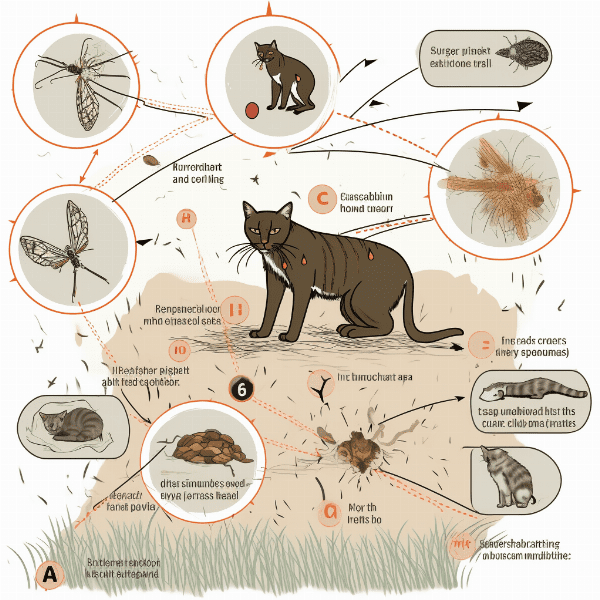
Symptoms of Zoonotic Infections in Cats
Zoonotic infections can affect cats, and some of these infections can also be transmitted to humans. It is important to be aware of the symptoms of zoonotic infections in cats to prevent their spread. In this section, we will discuss some common symptoms of zoonotic infections in cats.
Ringworm
Ringworm is a fungal infection that can cause a circular rash on a cat’s skin. The rash can be accompanied by hair loss and scaly patches. In some cases, the infected area may be itchy or painful. While ringworm is not usually serious, it can be difficult to treat and can be transmitted to humans.
Toxoplasmosis
Cats infected with Toxoplasma gondii may not exhibit any symptoms, but some may show signs of illness such as lethargy, fever, or loss of appetite. The infection can also cause diarrhea or constipation, which can lead to dehydration. In rare cases, infected cats may experience neurological symptoms such as seizures.
Cat Scratch Fever
Cat scratch fever can cause a variety of symptoms in cats, including fever, loss of appetite, and swollen lymph nodes. Some cats may also experience vomiting, diarrhea, or respiratory symptoms. In severe cases, the infection can cause liver or spleen damage.
Rabies
Rabies is a serious viral infection that can cause neurological symptoms in cats, including aggression, disorientation, and seizures. Infected cats may also exhibit unusual behavior, such as being overly friendly or exhibiting fear of water. Rabies is almost always fatal if left untreated.
Preventing the Spread of Zoonotic Infections in Cats
Preventing the spread of zoonotic infections in cats is important for both the cat’s health and the health of their human family members. Here are some ways to prevent the spread of zoonotic infections in cats:
- Keep cats indoors to reduce their exposure to infected animals and contaminated environments.
- Practice good hygiene by washing hands thoroughly after handling cats or cleaning litter boxes.
- Seek veterinary care if your cat exhibits any signs of illness or if you suspect they may have been exposed to a zoonotic infection.
- Keep litter boxes clean and away from food preparation areas to reduce the risk of contamination.
Conclusion
Being aware of the symptoms of zoonotic infections in cats is important for both cat owners and non-owners. By taking steps to prevent the spread of zoonotic infections and seeking veterinary care when necessary, we can protect the health of both cats and humans.

Prevention Measures for Zoonotic Infections
Preventing zoonotic infections is important for both the health of cats and their human family members. In this section, we will discuss some prevention measures that can help to reduce the risk of zoonotic infections in cats and their transmission to humans.
Keep Cats Indoors
Keeping cats indoors can help to reduce their exposure to infected animals and contaminated environments. Outdoor cats are more likely to come into contact with wildlife that may carry zoonotic infections, such as rabies. Keeping cats indoors also helps to prevent the spread of zoonotic infections by limiting their contact with other animals and reducing the risk of environmental contamination.
Regular Veterinary Check-Ups
Regular veterinary check-ups are important for preventing the spread of zoonotic infections. Cats should be vaccinated against preventable diseases, such as rabies, and tested for common infections, such as toxoplasmosis. Regular veterinary care can also help to detect and treat zoonotic infections early, before they can be transmitted to humans.
Protect Yourself During Pregnancy
Pregnant women are at greater risk of contracting some zoonotic infections, such as toxoplasmosis, which can be transmitted to the fetus and cause birth defects. Pregnant women should avoid contact with cat litter and have someone else change the litter box if possible. They should also practice good hygiene and avoid contact with cat feces or urine.
Educate Yourself and Others
Educating yourself and others on zoonotic infections can help to prevent their spread. Understanding the risks associated with zoonotic infections and how to prevent their transmission can help to protect both cats and their human family members.
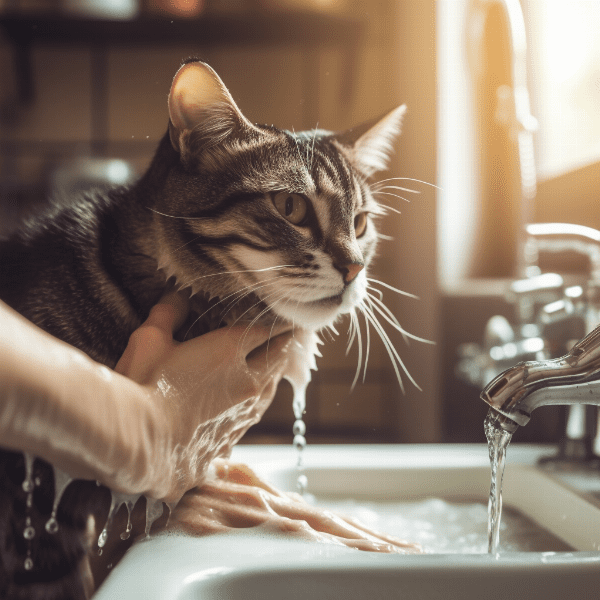
Treatment Options for Zoonotic Infections in Cats
Zoonotic infections can be serious and sometimes fatal for both cats and humans. It is important to seek veterinary care and medical attention promptly if you suspect that your cat or a family member has contracted a zoonotic infection. In this section, we will discuss some common treatment options for zoonotic infections in cats.
Antibiotics
Antibiotics are commonly used to treat bacterial infections, such as cat scratch fever. Your veterinarian may prescribe antibiotics if your cat has been diagnosed with a bacterial infection or if they suspect that a bacterial infection is present.
Antiparasitic Medications
Antiparasitic medications can be used to treat parasitic infections, such as toxoplasmosis. These medications may be given orally or by injection, depending on the severity of the infection. Your veterinarian may also recommend environmental decontamination, such as cleaning and disinfecting litter boxes, to prevent the spread of toxoplasmosis.
Supportive Care
In some cases, supportive care may be necessary to manage symptoms and prevent complications. This may include intravenous fluids, nutritional support, or pain management. Your veterinarian may also recommend isolation precautions to prevent the spread of zoonotic infections.
Conclusion
Zoonotic infections can be serious and sometimes fatal, but prompt veterinary care and medical attention can help to prevent complications and ensure a positive outcome. Treatment options for zoonotic infections in cats may include antibiotics, antifungal medications, antiparasitic medications, and supportive care. If you suspect that your cat has contracted a zoonotic infection, seek veterinary care immediately to protect their health and the health of your family.
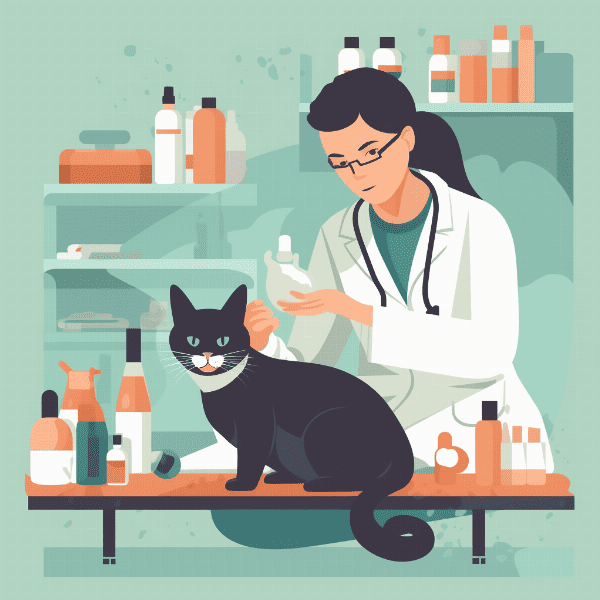
Importance of Regular Veterinary Checkups for Cats
Regular veterinary checkups are essential for maintaining the health and well-being of cats. In addition to preventing and treating common ailments, such as dental disease and obesity, regular veterinary care can also help to prevent the spread of zoonotic infections. In this section, we will discuss the importance of regular veterinary checkups for cats.
Preventative Care
Preventative care is an important aspect of regular veterinary checkups. During these checkups, your veterinarian will conduct a thorough physical examination to check for any signs of illness or disease. They may also perform diagnostic tests, such as blood work and urinalysis, to check for underlying health conditions.
Vaccinations
Vaccinations are an important component of regular veterinary care. Vaccinations protect cats from preventable diseases, such as rabies and feline distemper. Your veterinarian can help you develop a vaccination schedule that is tailored to your cat’s individual needs.
Detection and Treatment of Zoonotic Infections
Regular veterinary checkups can help to detect and treat zoonotic infections in cats. Your veterinarian can perform diagnostic tests to check for common zoonotic infections, such as toxoplasmosis and ringworm. Early detection and treatment of these infections can help to prevent their spread to humans.
Parasite Control
Parasite control is another important aspect of regular veterinary care. Your veterinarian can prescribe parasite prevention medications to protect your cat from fleas, ticks, and other parasites. These medications can also help to prevent the spread of zoonotic infections, such as Lyme disease.
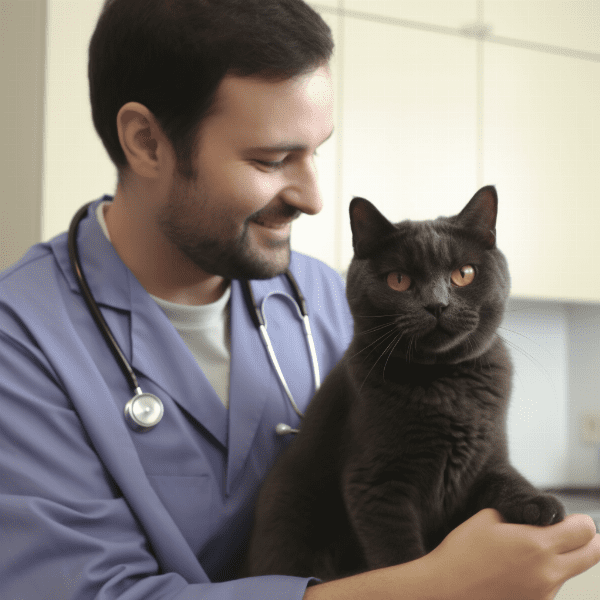
Educating Yourself and Others on Zoonotic Infection Risks
Educating yourself and others on the risks of zoonotic infections is an important aspect of responsible cat ownership. Understanding the potential risks associated with zoonotic infections and taking steps to prevent their transmission can help to protect both cats and their human family members. In this section, we will discuss the importance of educating yourself and others on zoonotic infection risks.
Know the Risks
Knowing the risks associated with zoonotic infections is an important first step in preventing their transmission. Some zoonotic infections are more common in cats than others, and some may be more severe than others. By educating yourself on the risks associated with zoonotic infections, you can take steps to prevent their spread and protect your cat and your family.
Understand How Zoonotic Infections Are Transmitted
Understanding how zoonotic infections are transmitted is another important aspect of zoonotic infection education. Zoonotic infections can be transmitted through direct contact with infected animals, such as bites or scratches, or through indirect contact, such as contact with contaminated surfaces or objects. By understanding how zoonotic infections are transmitted, you can take steps to prevent their spread.
Share Information with Others
Sharing information on zoonotic infection risks with others is an important aspect of responsible cat ownership. This includes educating family members, friends, and others in your community on the risks associated with zoonotic infections and how to prevent their transmission. By working together, we can help to prevent the spread of zoonotic infections and protect both cats and humans.
Conclusion
Educating yourself and others on zoonotic infection risks is an important aspect of responsible cat ownership. By knowing the risks, understanding how infections are transmitted, practicing good hygiene, and sharing information with others, we can help to prevent the spread of zoonotic infections and protect the health of both cats and humans.

The Role of Cat Owners in Reducing Zoonotic Infection Risks
Providing Proper Care
Providing proper care is an important aspect of responsible cat ownership. This includes regular veterinary checkups, vaccinations, parasite control, and good hygiene practices. By providing proper care for their cats, owners can help to prevent the spread of zoonotic infections and protect their cats and human family members.
Educating Themselves and Others
Educating themselves and others on zoonotic infection risks is another important role that cat owners can play in reducing the spread of zoonotic infections. By learning about the potential risks associated with zoonotic infections and sharing that information with others, owners can help to prevent the spread of infections and promote the health of both cats and humans.
Monitoring for Signs of Illness
Monitoring for signs of illness is an important aspect of responsible cat ownership. Cats that are showing signs of illness should be taken to the veterinarian promptly for evaluation and treatment. Early detection and treatment of zoonotic infections can help to prevent their spread to humans.
Practicing Good Hygiene
Practicing good hygiene is one of the most important ways to prevent the spread of zoonotic infections. This includes washing hands thoroughly after handling cats, cleaning litter boxes regularly, and using gloves when handling sick cats or cleaning up after them. Cat owners should also avoid contact with cat feces or urine to prevent the transmission of zoonotic infections.

Conclusion: Protecting Yourself and Your Feline Companion.
Zoonotic infections can pose a serious threat to the health of both cats and their human family members. By understanding the risks associated with zoonotic infections and taking steps to prevent their transmission, cat owners can help to protect both their feline companions and their families. In this section, we will summarize some of the key takeaways from this article.
Understanding Zoonotic Infections
Understanding zoonotic infections is an important first step in preventing their transmission. Zoonotic infections can be transmitted through direct contact with infected animals or through indirect contact with contaminated surfaces or objects.
Common Zoonotic Infections Transmitted by Cats
Cats can transmit a variety of zoonotic infections to humans, including toxoplasmosis, cat scratch fever, and ringworm. Symptoms of these infections can range from mild to severe and may include fever, fatigue, and rash.
Prevention Measures for Zoonotic Infections
Preventing the spread of zoonotic infections is essential for protecting the health of both cats and humans. This includes practicing good hygiene, keeping cats indoors, seeking regular veterinary care, protecting yourself during pregnancy, and educating yourself and others on zoonotic infection risks.
Treatment Options for Zoonotic Infections in Cats
Zoonotic infections can be serious and sometimes fatal for both cats and humans. Treatment options for zoonotic infections in cats may include antibiotics, antifungal medications, antiparasitic medications, and supportive care.
Importance of Regular Veterinary Checkups for Cats
Regular veterinary checkups are essential for maintaining the health and well-being of cats. In addition to preventative care, vaccinations, and parasite control, regular veterinary care can also help to detect and treat zoonotic infections.
The Role of Cat Owners in Reducing Zoonotic Infection Risks
Cat owners play an important role in reducing the risks of zoonotic infections for both their feline companions and human family members. By being proactive in their approach to cat care, owners can help to prevent the spread of zoonotic infections and promote the health and well-being of their cats and families.
Conclusion
In conclusion, zoonotic infections can pose a serious threat to both cats and humans. By understanding the risks associated with zoonotic infections and taking steps to prevent their transmission, cat owners can help to protect both their feline companions and their families. By practicing good hygiene, seeking regular veterinary care, and educating themselves and others, cat owners can help to ensure that their cats and families remain healthy and happy for years to come.




